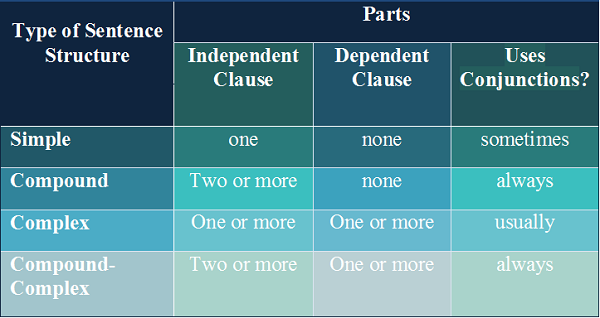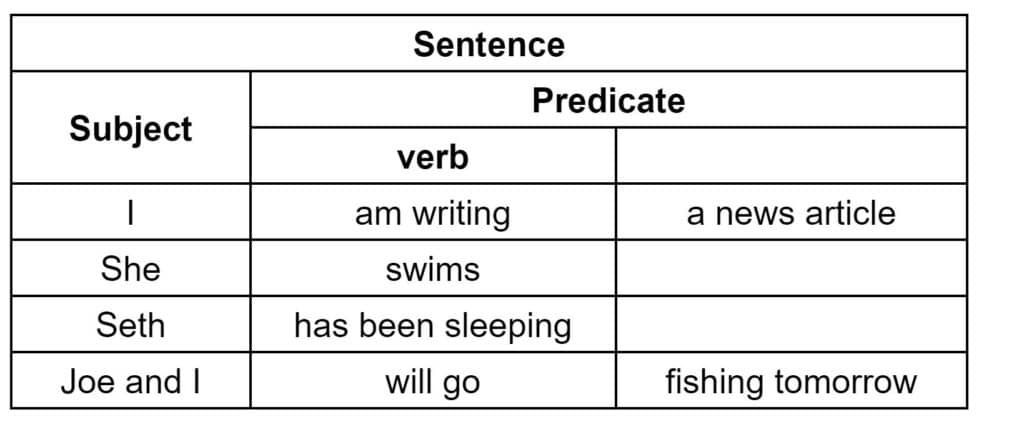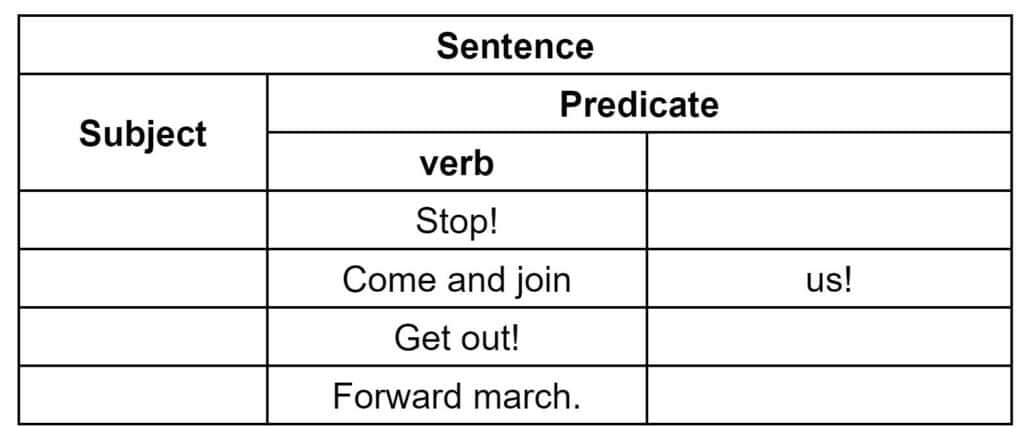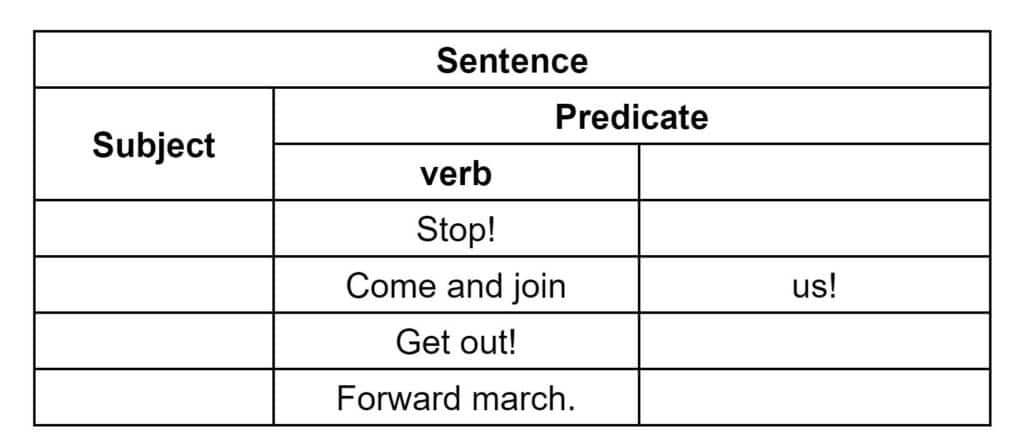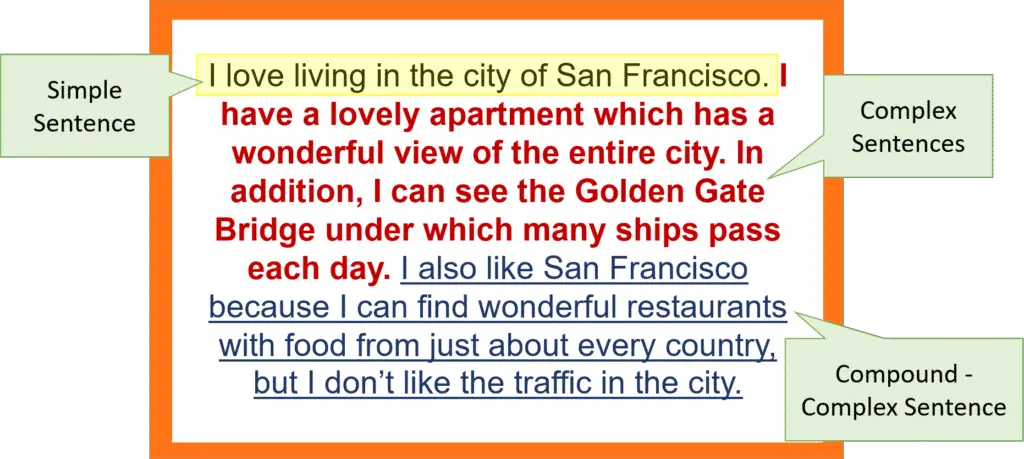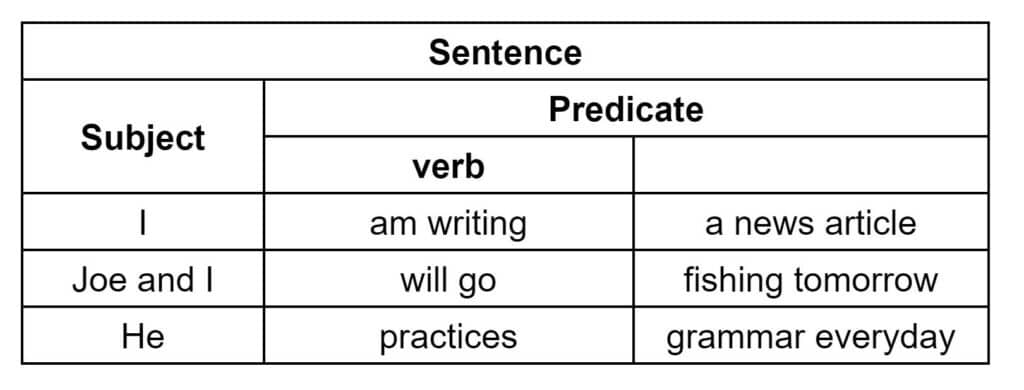1. What is Sentence Structure?
A sentence’s “structure” is the way its words are arranged.
In English, we have four main sentence structures: the simple sentence, the compound sentence, the complex sentence, and the compound-complex sentence. Each uses a specific combination of independent and dependent clauses to help make sure that our sentences are strong, informational, and most importantly, that they make sense!
2. Examples of Sentence Structures
In the examples, independent clauses are green, dependent clauses are purple, and conjunctions are orange. Here are examples of each type of sentence:
- The dog ran. Simple Sentence
- The dog ran and he ate popcorn. Compound sentence
- After the dog ran, he ate popcorn. Complex sentence
- After the dog ran, he ate popcorn and he drank a big soda. Compound-complex sentence
3. Parts of Sentence Structures
All forms of sentence structures have clauses (independent, dependent, or both), and some also have conjunctions to help join two or more clauses or whole sentences.
a. Independent Clause
Independent clauses are key parts of every sentence structure. An independent clause has a subject and a predicate and makes sense on its own as a complete sentence. Here are a few:
- The dog ate brownies.
- The dog jumped high.
- She ate waffles.
- He went to the library.
So, you can see that all of the clauses above are working sentences. What’s more, all sentences have an independent clause!
b. Dependent (Subordinate) Clause
A dependent clause is a major part of three of the four sentence structures (compound, complex, and compound-complex). It has a subject and a predicate; BUT, it can’t be a sentence. It provides extra details about the independent clause, and it doesn’t make sense on its own, like these:
- After he went to the party
- Though he ate hotdogs
- While he was at the dance
- If the dog eats chocolate
Each of the bullets above leaves an unanswered question. By itself, a dependent clause is just a fragment sentence (an incomplete sentence). So, it needs to be combined with an independent clause to be a sentence.
c. Conjunction
A conjunction is a word in a sentence that connects other words, phrases and clauses. Conjunctions are a big part of compound, complex, and compound-complex sentences. The most common conjunction that you know is “and.” Others are for, but, or, yet, and so. Conjunctions are important because they let us combine information, but still keep ideas separate so that they are easy to understand.
Here are two sentences, with and without conjunctions:
Incorrect: The girl ran to the ice cream truck then she ate ice cream.
Correct: The girl ran to the ice cream truck, and then she ate ice cream.
So, you can see that we need a conjunction for the sentence to be clear!
It is important to know that the word “then” is NOT a conjunction—it’s an adverb.
4. Types of Sentence Structures
As mentioned, there are four main types of sentence structures: simple, compound, complex, and compound-complex. To begin, here is a simple chart that outlines the patterns of each type.
a. Simple sentence
A simple sentence has only one subject and one predicate—one independent clause. In fact, an independent clause itself is a simple sentence. Here are some examples:
- She jumped.
- The cheetah ran.
- He ran to the gas station.
- He ate dinner.
Simple sentences don’t have many details and they don’t really combine multiple ideas—they are simple!
b. Compound sentence
A compound sentence has at least two independent clauses. It uses a conjunction like “and” to connect the ideas. Here are some examples:
- The dog ate pizza but the cat drank apple juice.
- The dog ate pizza but the cat drank apple juice and the fish had eggs.
As you can see, a compound sentence allows us to share a lot of information by combining two or more complete thoughts into one sentence.
c. Complex sentence
A complex sentence has one independent clause and one or more dependent clauses. It sometimes uses conjunctions and other words to combine all of the clauses together.
- When he was on the airplane, the man bought cookies.
- When he was on the airplane, the man bought cookies, but not brownies.
A great way to make a sentence more detailed is by adding dependent clauses (which couldn’t be sentences on their own). So, complex sentences let us add information to simple sentences.
d. Compound-complex sentence
A compound-complex sentence has two or more independent clauses and at least one dependent clause—so, it uses conjunction(s) to combine two complete sentences and at least one incomplete sentence. Here is an example:
The girl smelled cookies, which were baking at home, so, she ran all the way there.
The result of combining the three clauses and the conjunction is a compound-complex sentence that is both informational and easy to understand. The independent clauses give the main information, and the dependent clause(s) give the details.
5. How to Avoid Mistakes
When it comes to making sure your sentence is clear and complete, having the right sentence structure is very important. A couple of common mistakes can happen when you forget how to use clauses or conjunctions in the right way, like run-on sentences and fragment sentences.
a. Run-on sentences
In simple terms, a run-on sentence is a sentence that is too long. For instance, if a writer forgets to use conjunctions, a sentence seems like it “runs on” for too long. For example:
The fox really liked pancakes, he ate them every day for breakfast, he couldn’t eat them without syrup and butter.
But, with the right conjunctions, this can be a normal compound sentence:
The fox really liked pancakes, so, he ate them every day for breakfast; but, he couldn’t eat them without syrup and butter.
As you can see, the new sentence is much easier to read and makes more sense.
b. Fragment (incomplete) sentences
A “fragment” is a small piece of something. So, a fragment sentence is just a piece of a sentence: it is missing a subject, a predicate, or an independent clause. It’s simply an incomplete sentence. Fragment sentences can happen when you forget an independent clause.
For instance, by itself, a dependent clause is just a fragment. Let’s use a couple of the dependent clauses from above:
- While he was at the dance What happened?
- If he eats chocolate Then what?
As you can see, each leaves an unanswered question. So, let’s complete them:
- While he was at the dance, the dog drank fruit punch.
- The dog will get a stomachache if he eats chocolate.
Here, we completed the fragment sentences by adding independent clauses (underlined), which made them into complex sentences.
Test your Knowledge
1.
Which type of sentence combines two independent clauses?
a.Compound sentence
b.Simple sentence
c.None of the above
d.All of the above
2.
Which type of sentence can have two or more independent and dependent clauses?
a.Simple sentence
b.Compound-complex sentence
c.Compound sentence
d.None of the above
3.
Add a conjunction or conjunctions to make the following sentence clearer: The dog and the cat loved to eat ice cream, they liked going fishing, searching for clovers.
a.The dog and the cat loved to eat ice cream, they liked going fishing, and searching for clovers.
b.The dog and the cat loved to eat ice cream, so they liked going fishing, searching for clovers.
c.The dog and the cat loved to eat ice cream, and they liked going fishing, searching for clovers.
d.The dog and the cat loved to eat popcorn, and they liked going fishing and searching for clovers.
4.
Add an independent clause to complete the following sentence: If the rabbit goes to the dentist,
a.and
b.and gets a sticker.
c.he will get his teeth cleaned.
d.and his teeth cleaned.
English sentence structure refers to the different ways in which you can use word order and parts of speech to form sentences. Learning how to vary sentence structure in your writing and speech can also get you one step closer to English fluency! In today’s guide, we will look at sentence structure rules in English, the basic types of sentence structure, and how to vary your sentences in both English writing and speech. So, let’s get started!
What Is Sentence Structure in English?
If you’ve spent any amount of time studying English, you know that sentences can get pretty long and complicated. However, at their core, most English sentences adhere to specific sentence structure rules. More specifically, the basic sentence structure in English depends on two important elements: the subject and the predicate. Additionally, sentences can contain one or more objects, indirect objects, and complements.
- Subject – The subject of a sentence is the person, place, thing, or idea that is performing an action.
- The man laughed.
- Predicate – The predicate is the part of a sentence that contains the main verb and any modifying words or clauses.
- The man laughed.
- Object – The object is the person, place, thing, or idea that receives the action in a sentence.
- The man bought a newspaper.
- Indirect Object – The indirect object of a sentence signifies to whom or for whom an action is done.
- The man bought a newspaper for me.
- Complement – The complement refers back to the subject of a sentence. In order for a sentence to contain a complement, there must also be a linking verb.
- The man is a good person.
What are Clauses in English?
To fully understand sentence structure in English, you must also understand the role of clauses. There are two primary types of clauses in English: independent clauses (main clauses) and dependent clauses (subordinating clauses). An independent clause must contain a subject and a verb (predicate). Therefore, an independent clause can work independently from any other clause. Multiple independent clauses can even be linked together using a coordinating conjunction or a semicolon. For example:
- The woman worked.
- The woman liked her job, but she really wanted a promotion.
- Even though the job was great, the woman decided to quit.
- The woman quit her job and she never looked back.
- The woman quit her job; it was the best decision she ever made.
Alternatively, a dependent clause cannot stand on its own. In other words, a dependent clause depends on the presence of an independent clause to form a complete sentence. A dependent clause always begins with a subordinating conjunction or a relative pronoun. For example:
- The boy walked to school because he missed the bus.
- Since he was late for school, the boy couldn’t use his favorite seat.
- The teacher scolded him when he arrived.
- After that day, the boy felt embarrassed, because he was known as the boy who was late for school.
4 Types of Sentences in English
Now that you know the basic terms for different parts of a sentence, it’s time to start making sentences! There are four basic types of sentences that you can create: simple, compound, complex, and compound-complex.
- Simple Sentence – A simple sentence has one subject and one predicate. In other words, it is made up of one independent clause.
- The girl borrowed a book.
- Compound Sentence – A compound sentence has at least two subjects and two verbs. This means that a compound sentence has two independent clauses joined by a comma and a coordinating conjunction.
- I really love this author, but I don’t have time to read her new book.
- Complex Sentence – A complex sentence has one independent clause and at least one dependent clause.
- We laughed while we walked to the library.
- Compound-Complex Sentence – A compound-complex sentence has at least two independent clauses and at least one dependent clause.
- Since I couldn’t find my car keys, my roommate drove me to work, and I was very grateful.
How to Form a Simple Sentence in English
Ok, so we’ve covered a lot of information so far. Now you know the basic parts of a sentence, the two main types of clauses that make up English sentences, and the different types of sentences you can make. So, now let’s practice making some simple sentences!
Fortunately, sentence structure exercises don’t have to be tedious. Let’s begin with some of the most basic sentence forms to help get you started!
Subject-Verb
| Independent Clause | |
| Subject | Predicate |
| Verb | |
| Isabella | walks. |
| The dog | plays. |
| We | laugh. |
Can you think of some other examples? Simply replace any of the words in the “subject” column with a noun, noun phrase, or pronoun. Then, replace the word in the “verb” column with a verb that agrees with the subject. It’s that easy! Now let’s start adding some new elements:
Subject–Verb–Object
| Independent Clause | ||
| Subject | Predicate | |
| Verb | Object | |
| He | sees | a tree. |
| My teacher | reads | the book. |
| I | carried | my bag. |
Subject–Verb–Adjective
| Independent Clause | ||
| Subject | Predicate | |
| Verb | Adjective | |
| The man | feels | happy. |
| The painting | looks | creepy. |
| She | is | kind. |
Subject–Verb–Adverb
| Independent Clause | ||
| Subject | Predicate | |
| Verb | Adverb | |
| They | walk | quickly. |
| He | stares | intensely. |
| We | performed | well. |
How to Vary Sentence Structure
Needless to say, only using simple sentences (like those outlined above) will let you express very basic thoughts, attitudes, and information — but not much else. Therefore, you will need to vary your speech and writing patterns to include compound, complex, and compound-complex sentences. However, when it actually comes to varying sentence structure, thinking about the kind of sentence you want to make doesn’t help very much. In fact, it can make the process a lot more confusing than it needs to be.
Instead, focus on sentence length. Whether you’re writing or speaking, try to sprinkle in a mixture of short, medium, and long sentences. This will guarantee that you use more than one type of sentence structure.
Another great way to vary sentence structure is to include transition words. These words help your sentences sound more varied and give multiple statements a sense of continuity. Here are a few common transition words that you can put in the beginning or middle of sentences:
- And
- But
- However
- Therefore
- Moreover
- Thus
- Although
- Because
- Yet
Finally, remember to use different verb tenses. This doesn’t mean that you should suddenly switch from past to present, and then back to the past again. This might sound confusing. Instead, you should try to mix in different English tenses that make sense in the context of your speech or writing.
Conclusion
When it comes to sentence structure in English, it can feel like there’s a lot of ground to cover. You need to have a basic understanding of English grammar, vocabulary, parts of speech, clauses, as well as the different parts of a sentence. Fortunately, with time and practice, all of these sentence structure rules and terms will start to come naturally to you!
We hope you found this guide on English sentence structure useful! If you’d like to hear a native English speaker using varied sentence structures, be sure to subscribe to the Magoosh Youtube channel today!
Sentences in the English language come in a variety of forms and sizes, and it’s important for you to have a firm grasp of the different sentence patterns so that they may enhance the correctness and clarity of their own writing.
Whether using basic, compound, complex, or compound-complex sentences, a piece of writing with a diversity of sentence structures should be more dynamic and fascinating to read – and, as a result, should obtain a higher score.
As a result, this article will present the two basic sentence forms, simple and compound sentences, out of the four primary varieties.
However, before diving into particular sentence patterns, it’s critical to analyze the main aspects of a sentence so that we can effectively break any phrase down into its most relevant components.
What Are Sentence Structures?
In simple terms, a sentence is a group of words with a complete thought, either direct or implied. The standard structure contains:
- subject – what is being talked about
- predicate – adds more details to the subject
A predicate and a subject are required in every phrase; a predicate contains a verb which is an action, and a subject is a noun that performs the action.
The verb in this phrase is ‘am writing.’ The base form of the verb is writing, but in the present continuous, we conjugate it with the –ing form and the auxiliary word am. While the subject or the doer of the action is “I.”
The sample sentence above is quite brief. Of course, a sentence might be lengthier and more sophisticated, but a subject and a predicate are always there. Take a look at this more detailed example:
It’s worth noting that the predicate is always followed by a verb. In certain cases, the predicate is just a verb:
As a result, we may argue that a sentence must have both a subject and a verb.
The imperative, however, seems to be an exception. When giving an order (the imperative), most people do not utilize a subject. They don’t state what the topic is because it’s self-evident: it’s YOU! Consider the following imperative examples, both with and without a subject:
Because both of the preceding statements, ‘I rested’ and ‘My ice cream has melted,’ include both subjects and verbs, they create grammatical sentences despite their small length. Sentences may be considerably longer in reality, and they can be made longer by adding objects, complements, and adverbials.
Why are Sentence Structures Important?
Reason #1: Thorough Editing
The first way that knowing sentence structures confidently will help your academic performance is that it will make you a better editor. While certain grammatical faults may be overlooked by a reader because they have little impact on meaning, this is not the case with problems in sentence structure.
Consider the following sample paragraph to show how such mistakes might alter meaning in context:
Clearly, when sentence structures are written wrongly, as in the example above, the meaning of such phrases may become quite difficult to understand. When reading the same text after making the appropriate modifications and edits, see whether you can see a difference in incoherence and clarity:
Many frequent sentence construction problems, such as phrase fragments, comma splices, and sentence run-ons, may all be avoided with a better understanding of this area of grammar. As a result, a student with this understanding and a good editor’s eye should be able to write better academic writing.
Reason #2: Active Writing
Another reason to study sentence structure is to make your writing more interesting and livelier. Examine the two paragraphs below. The first paragraph has nine brief sentences, most of which have just one subject and one verb. Contrast this with the second paragraph, which just has four phrases and communicates the same meaning:
Varying your sentence structure, just like in paragraph (2), is not just making your writing more dynamic than paragraph (1) but also simpler and more enjoyable to read since it employs a diversity of language styles. Your writing should become more dynamic and diverse as well, assuming you comprehend and can employ a range of sentence forms.
What are the Different Types of Sentence Structure?
It’s possible to categorize sentences into four different categories. Previously, we looked at the minimal prerequisites for constructing a sentence. We may now examine the four different forms of sentence construction in further depth.
| Simple | Compound | Complex | Compound-Complex |
|---|---|---|---|
| “She likes reading books.” | “She likes reading thriller novels, and her brother loves listening to classical music.” | “While her brother loves listening to classical music, she is more interested in thriller novels.” | “While her brother loves listening to classical music, she is more interested in thriller novels, and she prefers to be in a serene place.” |
Simple Sentences
Following that, we’ll look at a simple sentence like I love scuba diving.’ This kind of sentence is as simple to learn and recognize as it sounds, and it is one of the first structures that each English student will practice making. You just need to memorize the following four guidelines to write basic phrases correctly.
One Subject and One Verb
Subjects and verbs are required in practically all clauses (and hence all sentence constructions. The easiest way to figure out how many clauses are in a sentence is to count the number of subjects and major verbs. Fortunately, since simple sentences only need one clause, this is a fast and straightforward task. To demonstrate, each of the following phrases is basic since it only has one subject and one major verb:
One Independent Clause
As previously stated earlier, sentences may be made up of one or more clauses, and clauses can be independent or dependent.
Simple sentences, on the other hand, usually include a single independent clause with a single subject and one major verb. Below are both independent clauses since they may stand alone as entire ideas and phrases:
In other terms, a sentence’s structure is simple if it consists of just one independent phrase.
Additional Functional Phrases
A simple sentence, like the three examples in the table, can include objects, complements, and adverbials in addition to the subject and verb. It’s important to remember that a simple sentence can have a lot of objects, adverbials, and complements, but it always has one subject and one verb phrase:
| Subject | Verb | Object | Complement | Adverbials |
|---|---|---|---|---|
| I | am writing | an article. | ||
| She | dances | gracefully | ||
| Seth | dove | into the pool |
Be mindful of compounded subjects/verbs
While we previously examined how simple sentences (and clauses in general) only have one subject, it is possible for such clauses to seem to have two subjects.
| Subject | Predicate |
|---|---|
| “Moises and Joyce” | “am writing a news article” |
Although these sentences seem to contain two subjects – ‘Moises’ and ‘Joyce’ – which have been united by the coordinate conjunction ‘and,’ these two subjects really constitute the single subject ‘we,’ as in ‘We are writing a news article.’ Even though there are two parts that seem to be independent topics, this sentence is nevertheless deemed simple in structure.
Compound Sentences
Compound sentences, on the other hand, must have two distinct subjects in order to be grammatical — however, these subjects should be spread out across two separate clauses rather than one.
Since compound sentences are one of the most popular of the four sentence forms, it’s critical for you to know how to utilize and recognize this sentence type correctly – especially in academic writing. The following four principles, similar to the rules for simple sentences, should be observed at all times if you want to utilize compound sentences appropriately in your written work.
Use Independent Clause Only
Compound sentences, like simple sentences, are made up of just separate clauses with both subject and predication and can stand on its own as full ideas and phrases. The employment of coordinating conjunctions like ‘and’ or ‘but’ to unite these clauses is one evident evidence of a compound phrase. If the phrase in issue, on the other hand, includes subordinating conjunction like ‘because’ or ‘even though,’ it is a dependent clause and not a compounded construction.
Use Can Use Multiple Independent Clauses
Compound sentences, unlike simple sentences, must include two or more separate clauses to be termed compound. To show compound structures with two or more separate clauses, consider the following examples:
Examples:
- “We were told to work on these pages, yet I am still confused about the task.”
- “I am confident, and I know I can make it to the finish line, but I am a bit worried.”
The compound sentence in:
- contains two separate clauses united by a comma (,) and the coordinate conjunction ‘and,’ while the compound phrase in
- has three independent clauses joined by commas and the conjunctions ‘but’ and ‘and.’
There is no grammatical limit to how many independent clauses may be combined in this manner in compound phrases like these; but more than three separate clauses in one sentence becomes difficult for readers to follow.
Structure Compound Sentences Correctly
When constructing compound sentences, you must learn to combine their independent clauses appropriately; otherwise, they may end up with ungrammatical run-on sentences, comma splices, and sentence fragments.
As seen in the preceding instances, the basic and most generally used rule is that every independent phrase should be coupled with a comma (,) and a coordinating conjunction (and, so, but, etc.).
When the writer wants to establish a stronger relationship between two independent clauses, he or she might use a semi-colon (;), which is likewise fully valid in compound sentences:
- “We had a meeting; we did not resolve anything.”
- “I am working on the project; I am not sure when it can be done.”
What isn’t grammatically correct is linking two distinct sentences with simply a comma, since this results in an ungrammatical comma splice, which is a sort of phrase run-on:
“We had a meeting, we did not resolve anything.”
Incorrect
“I am working on project, I am not sure when it can be done.”
Incorrect
A comma splice is when two distinct clauses are joined with a comma and no conjunction. Some people view this as a run-on phrase, while others see it as a punctuation mistake.
Compounding, in General, Should Be Avoided.
Finally, make sure that you don’t get mixed up between the general compounding of sentence parts like noun phrases and the merging of two or more separate clauses. Because both structures employ coordinating conjunctions like ‘and’ to unite their elements, such misunderstanding is likely to arise. As seen in the instances below, poor identification of these structures may lead you to employ inappropriate punctuation or conjunctions, resulting in grammatical structures:
Examples:
- “I am learning French and Spanish languages, and I am practicing everyday.”
In example (i), a comma (,) has been used to divide the two nouns ‘French’ and ‘Spanish,’ although the comma should be put before the second ‘and’ conjunction, not the first. This is because the second conjunction marks the combining of the two separate clauses that make up the grammatical compound phrase in the first place (i).
Complex Sentences
While simple and compound sentences are helpful while writing academically, you’ll also need to employ a range of complicated sentence forms to make your writing more dynamic and interesting. We will give three guidelines that you should grasp and follow attentively to help you recognize and use complicated phrases.
Have a Combination Independent with Dependent Clauses
Unlike simple and compound sentences, complex sentences need both an independent clause and a dependent clause to be deemed grammatical, as seen in the examples below. The independent clauses have been highlighted in both of these sentences:
- “He struggled badly with his exams because he did not study last night.”
- “Since he did not study last night, he struggled badly with his exams.”
Because (1) all sentence structures require at least one independent clause, and (2) these clauses have been joined with the bolded subordinate conjunctions because’ and ‘since,’ we can tell that these two example complex sentences are made up of a mixture of independent and dependent clauses. Subordinating conjunctions like these are often employed to introduce dependent clauses, which aren’t entire ideas or sentences on their own.
Expect to See a Wide Range of Dependent Clauses
While it may seem that the independent and dependent clauses in the preceding instances may be easily distinguished, there is such a wide range of dependent clause forms that this isn’t always the case.
In general, dependent clauses can join independent clauses with relative pronouns like ‘who‘ or ‘which,’ they can show the time or sequence of a clause with subordinate conjunctions like ‘since‘ or ‘while,’ and they can show the causal relationship between clauses with conjunctions like ‘because’ and ‘if.’ To aid in recognition of such sentence patterns, the four-alternative dependent-clause forms have been highlighted in bold below.
Various Kinds of Dependent Clause
| Adjective Clauses | We love the teacher who teaches our English subject. |
| Adverbial Clauses | Unless you pass the exam, you will surely fail the subject. |
| Noun Clauses | Are you aware of why we are here? |
| Non-finite Clauses | Nadia went to the village to visit her family. |
Notice how the dependent clause in the non-finite clause example ‘to visit her family’ appears to breach the first requirement of being a clause in that it lacks both a subject and a verb, instead of relying only on the word ‘visit.’ This is due to the fact that in non-finite clauses, the subject (in this example, ‘Nadia’) is deemed to be included inside the superordinating independent clause.
Correctly Punctuate Complex Sentences
Finally, you’ve undoubtedly noticed several differences in the punctuation and sequence of the preceding sample difficult phrases. It’s worth noting that, especially with adverbial clauses, the dependent or independent clause might be positioned either at the start or end of a sentence, depending on the writer’s preference:
| Dependent Clause | Independent Clause |
|---|---|
| “Since the Covid-19 cases are rising, students are still attending online classes.” | “Students are still attending online classes since the Covid-19 cases are rising.“ |
| “Although the majority of Indonesians are vaccinated, the government continuously reminds the population to be careful.” | “The government continuously reminds the population to be careful, although the majority of Indonesians are vaccinated.“ |
When putting the dependent clause first, however, writers must always include a comma (,) between the dependent and independent clauses to properly link them. When the independent phrase is at the beginning of the complicated sentence, however, a comma is not required – in fact, including one would be grammatically incorrect.
Compound-Complex Sentences
Compound-complex sentences, as the name implies, are the hardest to comprehend.
Longer, more difficult concepts may be expressed using compound-complex sentences, which have more elements than normal phrases. They’re useful for presenting complex concepts or detailing extensive sequences of occurrences.
Writers may simply generate a compound-complex sentence structure by combining compound and complex sentences, which will have at least two independent clauses and one dependent clause. In principle, a compound-complex sentence may be as long as it wants to be, but in fact, excessively long phrases might be difficult to understand.
The following compound-complex statement with eleven clauses, for example, is entirely grammatical despite its awkwardness:
The professor stepped onto the stage1 to make his guest appearance2, despite the fact that he wasn’t prepared3 to make a speech or deliver this lecture4, which he’d spent barely five minutes rehearsing5, to the audience of peers and students6 who sat eagerly awaiting the first word7 that would soon leave his mouth8, given confidence by years of experience9 and energized by the anticipatory crowd10.
| Adjective Clauses | 5, 7, 8, 9, 10 |
| Adverbial Clauses | 3 |
| Noun Clauses | 1 |
| Non-finite Clauses | 2, 4, 6 |
Sentence Run-Ons and Fragments
Now that you should be able to recognize and employ basic, compound, complex, and compound-complex sentence structures in your own writing, we should look at the sorts of errors that you tend to make while writing sentences. A run-on (or fused) phrase is the first major type of error.
When two whole phrases are mashed together without a coordinating conjunction or suitable punctuation, such as a period or a semicolon, run-on sentences are also known as run-on sentences.
Short or extended run-on phrases are acceptable. A lengthy phrase isn’t always synonymous with a run-on sentence.
Why Should Sentence Run-ons Be Avoided in English for Academic Purposes (EAP)?
Below are examples of run-on sentences made up of two separate clauses. It combines two entire ideas into a single statement with no punctuation:
| Incorrect | Correct |
|---|---|
| “Even though Lila prefers roses John gives her a bouquet of tulips instead.” | “Even though Lila prefers roses, John gives her a bouquet of tulips instead.” |
| “Lila liked the tulip bouquet John gave her on prom night, she loves roses.” | “Lila liked the tulip bouquet John gave her on prom night; however, she loves roses.” |
In example (a), the dependent clause ‘even though Lila prefers roses’ has been attached to the independent clause following it without the use of a comma (,), resulting in a complicated ungrammatical phrase.
Similarly, in example (b), two separate clauses have been joined into a compound phrase with just one comma, resulting in a comma splice. This method of joining two separate clauses is ungrammatical and should be avoided by you at all costs.
Thankfully, as the examples below show, there are two straightforward solutions to correct each statement.
In example (a), we can simply add a comma or reverse the order of the dependent and independent clauses, however in example (b), we may add coordinate conjunction or replace the comma with a semicolon (;).
When employing compound-complex sentences, things become a little more challenging since these structures may be virtually any length and yet be correct (although overly long sentences are admittedly difficult to understand).
It is consequently not the length of a phrase that determines whether it is regarded as a run-on but rather the presence or absence of improper or missing conjunctions and punctuation.
With this in mind, there are three common methods for students to construct sentence run-ons rather than correct sentences, and students should learn to avoid each:
Connecting Two Independent Clauses + Conjunctive Adverb
| Incorrect | “The flight was delayed for an hour, nevertheless, the passengers did not mind.” |
| Correct | “The flight was delayed for an hour; nevertheless, the passengers did not mind.” |
| Correct | “The flight was delayed for an hour. Nevertheless, the passengers did not mind.” |
Using a Pronoun Antecedent in the Second Independent Clause
| Incorrect | “The Angat Dam was heavily damaged, it was not built properly.” |
| Correct | “The Angat Dam was heavily damaged because it was not built properly.” |
| Correct | “The Angat Dam was heavily damaged; it was not built properly.” |
Adding a command as a Second Independent Clause
| Incorrect | “We might have unfavorable weather, bring an umbrella.” |
| Correct | “We might have unfavorable weather, so bring an umbrella.” |
| Correct | “We might have unfavorable weather. Bring an umbrella.” |
When conjunctive adverbs like ‘although’ and ‘therefore’ are used to connect two separate clauses in scenario 1, a semicolon (;) should come before the adverb, and a comma (,) should come after it. Scenarios 2 and 3 are, however, somewhat different.
Both of these examples include comma splices, which occur when a comma is used wrongly to combine two separate clauses – a typical mistake.
Thankfully, using the correct conjunction and/or punctuation mark may typically correct such problems quickly.
What are the Grammar Rules for Creating Various Sentence Structures?
You must also obey the grammatical rules in addition to understanding the elements of a phrase.
Here’s a short rundown in case you forgot:
- In a sentence, capitalize the initial letter of the first word.
- Use a period, a question mark, an exclamation point, or quote marks to end a phrase.
- The subject of the sentence usually appears first, followed by the verb, and then the objects. (Subject -> Verb -> Object)
- If the subject is single, the verb must be singular as well. Subject-verb agreement occurs when the verb must be plural if the subject is plural.
Are Sentence Structures Challenging for Students?
When it comes to sentence building, it’s not just about grammar; it’s also about style and flow. A range of sentence lengths and styles are used in effective academic writing. Overly lengthy sentences might be confusing to readers, while too many extremely short sentences can make your content seem jagged and fragmented.
Don’t Use Run-on Phrases.
An independent clause is has a complete thought and that may stand alone. Independent clauses may be combined in a variety of ways, but when they are joined without adequate punctuation, a run-on phrase results.
Run-on sentences are a grammatical issue, not a long one; even short phrases may include this problem. Run-on phrases are the consequence of two typical errors.
| Incorrect | Correct | |
| Comma Splice | “Nadia loves to take cream and sugar with her tea, when she drinks it warm, she also likes it black.” | “Nadia loves to take cream and sugar with her tea; when she drinks it warm, she also likes it black.” |
Sentence Fragments Should be Avoided.
Remember that fragments are groups of words that lack all of the elements of a complete sentence. To be considered complete, a sentence must contain a subject and a predicate.
Sentence fragments are frequently used stylishly in journalism and creative writing, but they are seldom acceptable in academic or other formal writing.
| Incorrect | Correct | |
| Missing subject or predicate | “The newspaper article today” | “The newspaper article today is very controversial.” |
| Very controversial | ||
| A dependent clause | “When the sky is clear” | “The sky is clear.” |
Overly Long Sentences Should Be Broken Up.
A lengthy sentence may be grammatically accurate, yet it is difficult to follow due to its length. Avoid using too many overly long sentences in your writing to make it clearer and more readable.
Take note that a typical sentence is usually 15 to 25 words long. If your sentence becomes longer than 30-40 words, you should consider revising it. Getting rid of redundancies and inflated phrases is a good place to start, but if all of the words in a sentence are necessary, try breaking it up into smaller sentences.
| Incorrect | Correct |
| “While numerous previous studies have shown that there are 80% of Filipinos are willing to get a Covid booster, our data show that the percentage of people who refuse to obtain a booster dosage varies little by region, ranging from 6-7 percent.” | “While numerous previous studies have shown that there are 80% of Filipinos are willing to get a Covid booster.
Our data, however, show that the percentage of people who refuse to obtain a booster dosage varies little by region, ranging from 6-7 percent.” |
Join Sentences that are Too Short Together.
Shorter sentences are usually cleaner and easier to read, but too many of them may make writing appear jagged, fragmented, or repetitious. Use transition words and a range of sentence lengths to let readers understand how your thoughts fit together.
| Incorrect | “San Francisco is one of my beloved cities to live in. I live in a beautiful apartment. It provides a spectacular perspective of the whole city. Underneath, I can see the Golden Gate Bridge. Every day, a great number of ships pass through. San Francisco is also a favorite of mine. I can discover fantastic restaurants that serve cuisine from almost every nation. The city’s traffic irritates me.” |
| Correct | “San Francisco is one of my beloved cities to live in, and I live in a beautiful apartment. In addition, it provides a spectacular perspective of the whole city. Underneath, I can see the Golden Gate Bridge. Every day, a great number of ships pass through. San Francisco is also a favorite of mine, where I can discover fantastic restaurants that serve cuisine from almost every nation; however, the city’s traffic irritates me.” |
7 Best Tips in Varying your Sentences
The necessity to alter your syntax and written rhythms to keep your reader interested is a crucial part of the writing process. Word choice, tone, vocabulary, and, perhaps most importantly, sentence structure are all examples of diversity.
When reading a book, news story, or magazine article, readers strive for sentence diversity, even if they aren’t aware of it. No matter what writing style you use, one of the finest writing advice a first-time author can get is to use a variety of sentence structures.
Here are some writing strategies to help you add diversity to your sentences.
Enjoying brevity
If your first statement is complex, keep your second sentence brief and straightforward. Shorter phrases with no unclear words are strong. The reader is engaged when you write with clarity and conciseness.
Simple Sentences After Lengthy Phrases
A thick sentence is one with at least two independent clauses and one dependent clause. Simplifying statements are excellent, but repeating them may be boring. If you compose one, use a different sentence type.
Avoid Using Passive Voices.
Active voice verbs describe the action. “He caught the ball.” This sentence conveys the same information in a less pleasant manner. A passive statement might adequately describe a situation, but you should usually employ the active voice.
Use a Mix of Transitions.
“However,” “therefore,” “moreover,” and other conjunctive adverbs may be used as transition words. These terms are excellent as long as you don’t use pet phrases.
Using Semicolons Reduces Conjunctions.
A compound sentence joins two separate clauses with a coordinating conjunction. To add variety to your sentences, use a semicolon after the first independent clause. But you’ve introduced variation to your sentence patterns.
Start Paragraphs with a Concise Thesis Statement.
A thesis statement is a straightforward and declarative phrase. Generally, longer sentences are preferable to shorter ones. In the body of your paragraphs, elaborate on these claims.
Use Rhetoric.
Rhetorical questions are assertions posed as questions to arouse curiosity. “What if there was no war?” These lines work well in both creative and content writing. Use them wisely.
Exercises in the Different Sentence Functions
Determine whether the sentence is simple, compound, complex, or compound-complex.
- Tony raced his scooter up the hill.
- Though Sarah was healthy, she sometimes felt weak.
- After eating, Nate felt sleepy.
- I love reading books and magazines, and I prefer reading in a quiet place.
- Nate wants to get to the bus quickly because he is tired and wants to rest.
- Animals should not be slaughtered for their fur, yet it still happens.
- I came to study in the UK because I wanted to enhance my English; therefore, I chatted to as many English people as possible.
- Pollution is common, yet nothing is done to avoid it.
- He failed the exam for lack of preparation.
- She came to class late.
Rearrange the words to make meaningful sentences.
- Sudha / stand / class / studying / is / in / to / her / first
- birds / free / to / caged / campaigned / he
- flows / without / time / any stop / on
- oil / depends / the / industry / the / on / forests
- crowded / last Sunday / railway platform / unusually / the / was
Connect the sentences using the correct conjunction.
- The expense of transferring a corporation from the city to a regional area is significant. You have to create new facilities.
- Our species must evolve. We are naturally sluggish.
- Copyright laws encourage innovation. The creator’s works of art are protected by copyright laws.
- Family members like using Skype to communicate. Family members may now speak with each other for free from anywhere on the planet.
- Technology has modified our way of living. It made it a lot easier. There are also advantages and disadvantages.
Additional Reading — ENGLISH GRAMMAR
All sentence may
divided into simple and composite. Simple sentences ate divided into
one member and two member. Primary member of a sentence: subject
and predicate. Secondary members: object, adverbial modifier,
attributive
One
traditional scheme for classifying English
sentences is by the number and types of finite
clauses:
-
A
simple
sentence
consists of a single independent
clause
with no dependent
clauses. -
A
compound
sentence
consists of multiple independent clauses with no dependent clauses.
These clauses are joined together using conjunctions,
punctuation,
or both. -
A
complex
sentence
consists of at least one independent clause and one dependent
clause. -
A
complex-compound
sentence
(or compound-complex
sentence)
consists of multiple independent clauses, at least one of which has
at least one dependent clause.
11) Simple sentence. Main features of the simple sentence.
It has been
usual for some time now to classify sentences into two-member and
one-member sentences. SIMPLE
SENTENCE— A simple sentence is
one
that consists of a single independent clause
and
no subordinate clauses. The simple sentence
always
contains one subject and one verb.
For
example:
The
command chaplain
supervised
the
program.
Simple
sentence comprises a subject and a predicate (as well as secondary
parts of a sentence): She (subject) invited (predicate) us to dinner.
It
requires a subject and a verb. We ordinarily include some additonal
words that explain the subject. The sentence or a part of a sentence
that contains a subject and a verb and constitutes a complete thought
is called an independent
clause.
I
like
English. The
sentence above conveys a complete thought. The subject is I,
and the verb is like.
The word English conveys an understanding of what
the subject likes. The sentence has one independent clause and is a
simple sentence. Observe the arrangement or sequence of sentence
components: subject, verb, other parts of the sentence. This
arrangement is not mandatory, but sentences written in this format
are usually easy to understand.
12) One member sentence. It peculiarities.
Its subject and
predicate. One member is a sentence which contains one of the
primary member of a sentence. There are sentences which do not
contain two such separate parts, in this sentences there is only one
main part is not there and it could not even be supplied, at least
not without a violent change in the structure of the sentence( fire!
Come on!) or opening sentence of (dusk-of a summer night)
-
Simple sentence. Two member sentence
In a sentence
like helen sighed there obviosly are two main parts: helen, which
denotes the doer of the action and is called subject, and sighed,
which denotes the action performed by the subject and is called
predicate. Sentences having this basic structure, a word to denote
the doer of the action and another word to denote the action, are
termed two-member sentences
Соседние файлы в предмете [НЕСОРТИРОВАННОЕ]
- #
- #
- #
- #
- #
- #
- #
- #
- #
- #
- #
To understand appropriate sentence structure is to understand the grammatical building blocks of the English language. By having a strong grip on the structures of your sentences, you will be a more versatile writer. In this article, we’ll break down what sentence structure is, what the four types of sentence structures are, and how to use them.
First, let’s define sentence structure
Unless you’re an English major, chances are you haven’t studied the mechanics of the language in quite some time. Sure, you can probably write and speak in complete sentences but that’s just the first step. Knowing what sounds right vs. knowing why it is right are two very different levels of mastery.
So, consider this a brief re-education on how sentences work. Before we get into the various types there are, let’s define what we mean when we talk about English sentence structure.
SENTENCE STRUCTURE DEFINITION
What is Sentence Structure?
Sentence structure is how the basic grammatical elements (a subject, predicate, and sometimes direct or indirect objects) of a sentence are put together. The rules for how a sentence is constructed are simple but firm. These include the necessity for a subject, predicate, and object (in that order) in every sentence. Beyond that, we can add additional elements like prepositions and dependent clauses. Advanced sentences can weave these elements together to create more and more complex structures. There are four types of sentence structure (listed below).
Types of Sentence Structure:
- Simple
- Compound
- Complex
- Compound-complex
Still unsure about sentence structure rules? This video helps illustrate each component that makes a sentence a sentence, and then delves into each structure type (we’ll also get into that next).
What is sentence structure?
Structure Examples
4 types of sentence structure
Now that we’ve tackled “what is sentence structure,” let’s look more in depth at its different types.
Simple Sentences
The most basic type of English sentence is the simple structure. This is when a sentence is composed of just one independent clause – a clause which contains a subject (the noun performing the action of the sentence) and predicate (the action being taken) and expresses a complete thought. Like all sentences, it can also contain a direct object (the noun receiving the action of a sentence) or indirect object (the object for whom the action is being done).
A few simple sentence examples:
- I didn’t go to the game.
- She was correct.
- The writer was out of ideas.
- The movie was over two hours long.
Compound Sentences
The compound sentence combines two or more independent clauses with a coordinating conjunction (or, and, but, yet, for, nor, so) or a semicolon.
Here are some examples:
- She was sick, so she didn’t go to school.
- Greg kept his distance; he knew he was a dangerous man.
- I was exhausted, but I worked all night.
- Mom was still at work, and Dad was out to dinner.
Notice how all of these sentences could be broken into two: “She was sick. She didn’t go to school.” “Mom was still at work. Dad was out to dinner.” That’s because these sentences contain 2 independent clauses, which can be turned into simple sentences.
Complex Sentences
Complex sentences consist of an independent clause and a dependent clause. A dependent clause is an incomplete thought (e.g., “Although I was sick, …” “Because he was gone, …”) and thus needs to be attached to an independent clause. It’s also known as a subordinate clause.
Some complex structure examples:
- If he was so funny, the whole crowd would have been laughing.
- I went to dinner because I was hungry.
- She turned her down because she was in love with someone else.
Compound-Complex Sentences
True to their name, compound-complex sentences combine the ideas behind both compound and complex sentences: they contain at least two independent clauses and a dependent clause.
Because they can be pretty hard to parse, I’ve color coded the independent clauses, the coordinating conjunction/semicolon, and the dependent clauses. Let’s take a look:
- Because he was injured,
the team played with a short bench
and their rivals beat them soundly. - I wondered what became of him;
if he liked Chicago so much, it made no sense for him to up and leave. - The teacher gave Jimmy a time-out
because of his bad behavior
and we all laughed at him, reveling in the chaos he had wrought.
Sentences contain a lot of moving parts, and these structures tackle just a small portion of sentence grammar. For a more comprehensive look at all the parts of a sentence, check out this video:
What is Sentence Structure?
This might all seem abstract, but there’s a good reason to know about English sentence structure and composition.
How Sentences Are Structured
Why sentence structure?
You might be thinking that proper sentence structure is one of those things that you use but don’t need to understand. We all write different structures even though we might not necessarily be cognizant of it.
But paying attention to basic sentence construction is a great way to look at the rhythm of your writing more carefully. Have you written three complex sentences in a row? Or maybe you’ve been leaning heavily on simple sentences? Too much of one structure can lead to your writing feeling repetitive or dull.
Or, on the other hand, if you want to create a purposeful repetition in your rhetoric, reusing a sentence form and structure can help with that.
Knowing how sentences are structured can help you become a more thoughtful and varied writer. Who doesn’t want that?
UP NEXT
What are Literary Devices?
Now that you’ve nailed down the appropriate structure for sentences, it’s time to up your writing game with some tried and true techniques used by everyone from Aristotle to Aaron Sorkin. Dive into our comprehensive guide to literary devices, elements and techniques.

